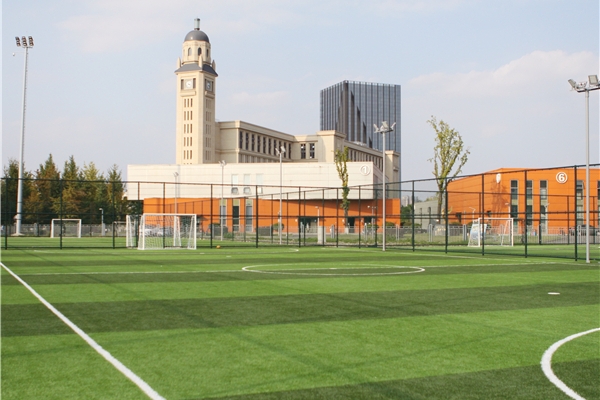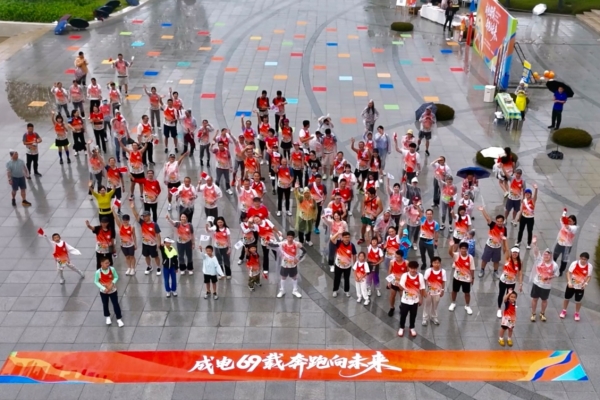即可将网页分享至朋友圈
为搭建我校博士后之间的学术交流平台,促进学术水平提升,学校博士后管理办公室组织开展博士后学术沙龙活动。本次沙龙由我校博士后林峰、薛娟、吕锐、陈之迪分享其研究成果,诚挚邀请感兴趣的师生参加。
一、时 间:2021年5月26日(周三)14:30
二、地 点:沙河校区通信楼818会议室
三、主办单位:电子科技大学博士后管理办公室
四、承办单位:基础与前沿研究院
五、活动安排:
报告一:
(1)主题:Marangoni Convection-Driven Laser Fountains and Waves on Free Surfaces of Liquids
(2)主讲人:林峰 基础与前沿研究院博士后
(3)交流内容:
It is well accepted that an outward Marangoni convection from a low surface tension region will make the surface depressed. Here, we report that this established perception is only valid for thin liquid films. Using surface laser heating, we show that in deep liquids a laser beam actually pulls up the fluid above the free surface generating fountains with different shapes. Whereas with decreasing liquid depth a transition from fountain to indentation with fountain-in-indentation is observed. High-speed imaging reveals a transient surface process before steady elevation is formed, and this dynamic deformation is subsequently utilized to resonantly excite giant surface waves by a modulated laser beam. Computational fluid dynamics models reveal the underlying flow patterns and quantify the depth-dependent and time-resolved surface deformations. Besides liquid temperature field and transient surface deformation, the observations of reduced liquid elevation under reduced surface tension or increased laser heating depth further confirm Marangoni effect rather than thermogravity convection as the driving force for laser fountains. Our discoveries and techniques have upended the century–old perception and opened up a new regime of interdisciplinary research and applications of Marangoni-induced interface phenomena and optocapillary fluidic surfaces – the control of fluids with light.
(4)主讲人简介:
Feng Lin received his bachelor's degree in Electronic Science and Technology (2013) and Ph.D. degree in Materials Science and Engineering (2019) from University of Electronic Science and Technology of China (UESTC). He has been supported by China Scholarship Council and UESTC to work as a joint Ph.D. student in University of Houston from 2016 to 2019. He is currently a post-doctoral fellow of Institute of Fundamental and Frontier Sciences, UESTC. His research interests focus on the macroscopic orientation control of low-dimensional nanomaterials, photoacoustic streaming and optical characterization of nanomaterials.
报告二:
(1)主题:Cellulose Nanocrystal-Templated Synthesis of Mesoporous TiO2 with Dominantly Exposed (001) Facets for Efficient Catalysis
(2)主讲人:薛娟 基础与前沿学院博士后
(3)交流内容:
In this talk, we briefly discuss the current issues on cellulose nanocrystals (CNCs). At present, it is still mainly focused on physical and chemical parameters of CNCs, liquid crystal fingerprint texture, pitch and structural color control, and how to establish the interrelation between gel network structure and structural color has not been studied. Because of this limitation, it is rarely reported that using CNCs to develop a functional material with iridescent structural color, as well as to accomplish the controlled growth of inorganic nanoparticles in the confined space formed by self-assembly of CNCs.
By using 3.5 wt%, 8.7 wt% and 11.3 wt% of CNCs as bio-template, three kinds of TiO2 were prepared via a stepwise heating procedure. As detected by TEM, SEM, XRD and BET, all TiO2 owned mesoporous structure and (001) facets, and the proportion of (001) facets as well as crystallinity increased with the increase of the CNCs concentrations. In order to impart visible light response to TiO2, Te-dot was incorporated to construct TiO2/Te-dot nanocomposites. The morphology was characterized by TEM and HRTEM. The chemical structure was analyzed by FTIR and XPS. The crystal and pore structures were analyzed by XRD and BET. The results showed that TiO2/Te-dot maintained the pore structure and (001) facet of TiO2, and Te=O chemical bond was formed between TiO2 and Te-dot. Meanwhile, as the concentration of the template increased, the crystallinity and (001) facet content increased. The photocatalytic activity of TiO2/Te-dot nanocomposites was evaluated by determining the photodegradation behavior of rhodamine B. The results showed that the photocatalytic efficiency of TiO2/Te-dot nanocomposites increased with the increase of CNCs concentration. Besides, the as-prepared TiO2/Te-dot nanocomposites were photocatalytically stable and suffered no photocorrosion.
(4)主讲人简介:
J. Xue received the Bachelor degree from Lanzhou University and Ph.D. degree from the Sichuan University of polymer science and technology, in 2013 and 2019, respectively. She currently works as a Postdoctoral Fellow in the School of University of Electronic Science and Technology of China. Dr. Xue is working in the field of science and technology. Her main research interests include cellulose nanocrystals (CNCs), liquid crystal, structural color, photocatalysis and sensor.
报告三:
(1)主题:双折射光楔傅里叶变换光谱仪应用于可见光和近红外拉曼光谱探测
(2)主讲人:吕锐 基础与前沿研究院博士后
(3)交流内容:
傅里叶变换型光谱仪具有扫描速度快,波数精度和分辨率高以及测量灵敏度高的优点。在红外波段,其优势已经得到了普遍认可,当前,小型化和便携化是傅里叶变换型光谱仪的重要发展方向,而傅里叶变换型光谱仪的优势在可见光波段是否依然能得以发挥,也是一个尚待证实的问题。本次报告中,我将介绍设计和搭建新型双折射光楔傅里叶变换光谱仪的最新进展。
传统的傅里叶变换型光谱仪都是通过迈克尔逊干涉仪或在此基础上改进的结构来实现光程差的控制。为得到高分辨率的光谱数据,需要借助参考光和具有主动反馈的设计来实现动态校正,这大大增加了系统的复杂性,且对于可见光和近红外波段,实现相应的步进精度是较为困难的。这里我们使用了Nireos公司研发的Gemini干涉仪(https://www.nireos.com/gemini),是完全不同的结构,利于晶体的双折射产生光程差,通过调节双折射光楔的位置实现了共路光束的干涉。相关的报道指出,这种设计无需使用参考光和主动反馈,光程差的高精度和稳定性依然可达λ/300(A. Oriana, et al. JOSA A 33.7 (2016): 1415)。我们计划自主搭建一套包括激光源,光路系统,Gemini干涉仪,探测器和数据采集分析,样品扫描台等几个部分的完整的傅里叶变换光谱测量系统。目前,我们已经实现了对匀质液体中染料分子的荧光信号的测量,我将分享最新的实验结果,并就当前遇到的挑战,及系统下一步的搭建和调试与大家讨论。
(4)主讲人简介:
吕锐博士,2013本科毕业于南京大学物理系,2019年于University of California, Riverside 取得博士学位,博士期间研究方向为二维材料的表征,器件制备和低温输运测量。目前是电子科技大学基础与前沿研究院博士后,在站期间,计划开展关于光电探测与传感,二维材料近场光学性质相关项目的研究。
报告四:
(1)主题:Pearling and helical nanostructures of model protocell membranes
(2)主讲人:陈之迪 基础与前沿研究院博士后
(3)交流内容:
The diversity of protocell membrane structures is crucial for the regulation of cell activities and indispensable to the origin of life. Prior to the evolution of complex cellular machinery, spontaneous protocell membrane evolution results from the intrinsic physicochemical properties of simple molecules under specific environmental conditions. Here, we report the evolution of the morphology of cell-sized model protocell membranes from giant vesicles to pearling and helical nanostructures, resembling morphologies of eukaryocytes, nostoc and spirilla. This evolution occurs in a single binary aqueous system composed of an achiral single-chain amphiphile and a biogenic polyamine (spermidine or spermine) upon evaporating water, feeding amphiphiles or increasing pH in response to various primitive fluctuating conditions. In contrast, nonbiogenic polyamines (triamine, triethylenetetramine and hexamethyltriethylenetetramine) with slight differences in the number of methylene groups or protonated amine groups do not induce such a kind of evolution. The evolution of the shape transformation strongly relies on the balance between electrostatic attraction and hydrogen bonding, attributed to the odd/even effect of polyamines in the assembly. Strikingly, both pearling and helical structures emerge from multilamellar vesicles undergoing different processes, where the helix shows stronger permeability and encapsulation capability due to its multicompartmentalized structure. Thus, subtle adjustment of weak intramolecular interactions not only yields significant changes in the morphological evolution of protocell membranes but also brings new insights into the natural inevitability of biogenic small molecules.
(4)主讲人简介:
Z. D. Chen received the Bachelor degree from University Of South China and Ph.D. degree from the Institute of Chemistry, Chinese Academy of Sciences in 2013 and 2019, respectively. She currently works as a Postdoctoral Fellow in the School of Institute of Fundamental and Frontier Sciences of UESTC. Dr. Chen is working in the field of colloid and smart interface. Her main research interests include nanostructures; self-assembly; contact electrification.
编辑:林坤 / 审核:林坤 / 发布:陈伟


